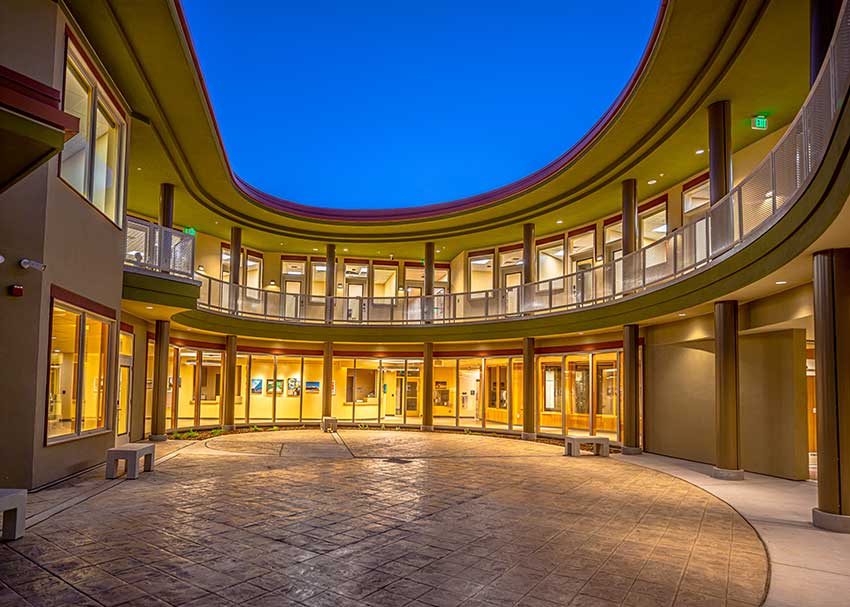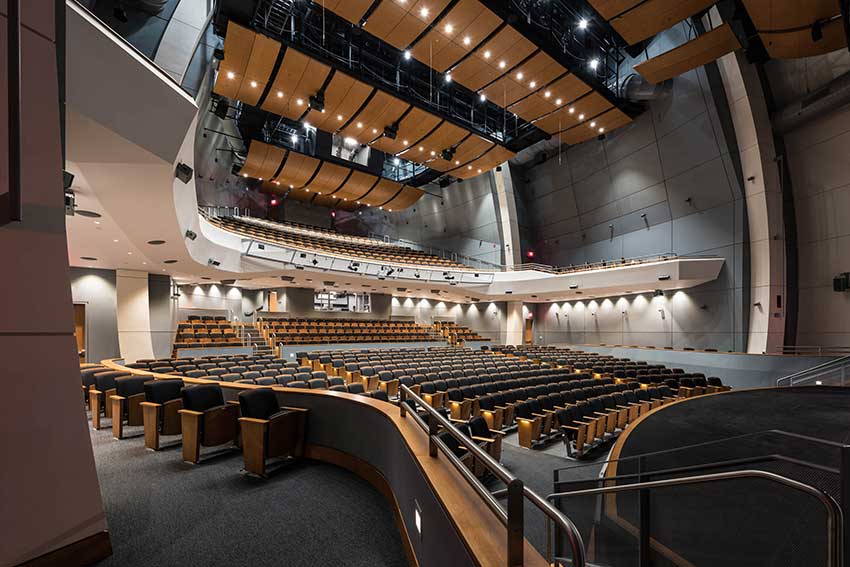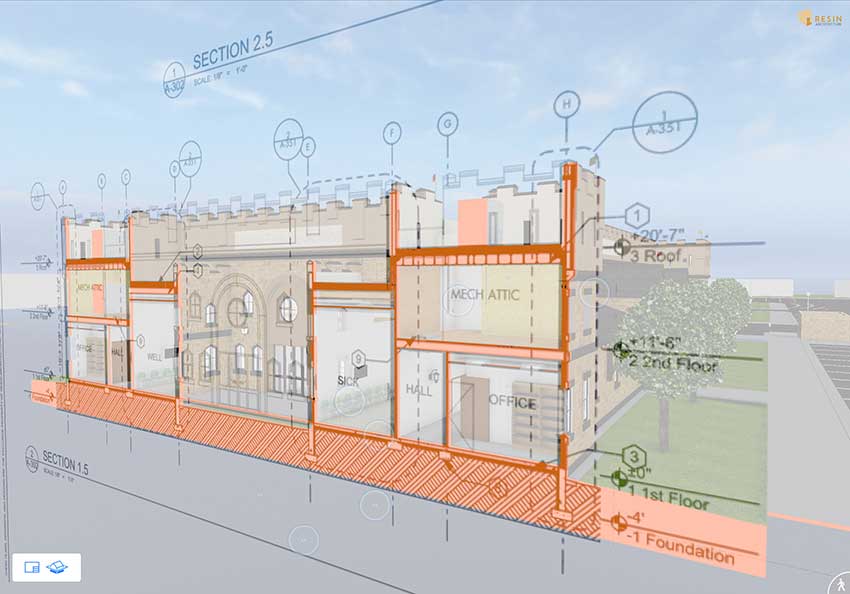This CE Center article is no longer eligible for receiving credits.
Modern design software has evolved way past the point of simple 2D and 3D renderings. The BIM work process, coupled with innovative developments in design software, enables real-time collaboration among all project stakeholders. Designers and MEP and structural engineers can visualize all aspects of the design process in complete 3D renderings and, in doing so, can incorporate progressive and innovative sustainable design options seamlessly into the plans. By taking advantage of the technology available, architects and designers can reduce design time, improve communication, and identify and resolve potential design conflicts, while fostering a supportive remote workforce.
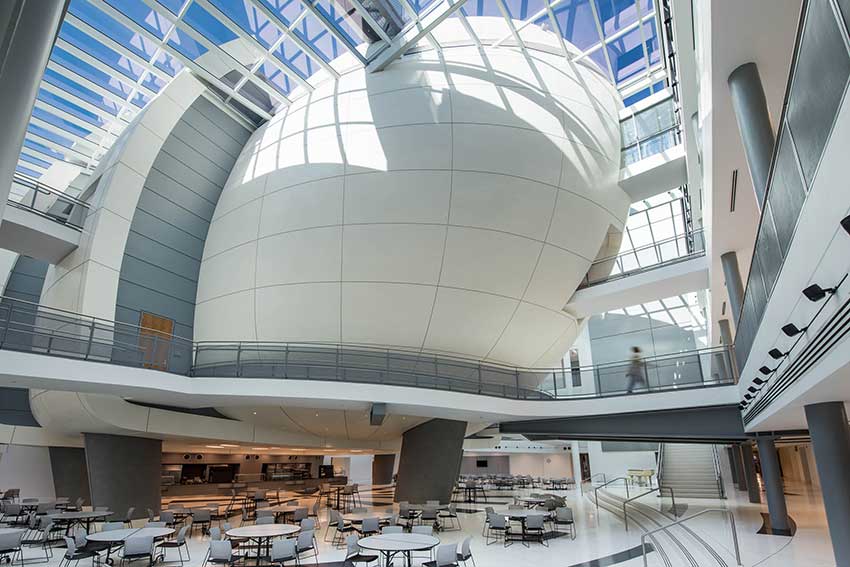
Photo courtesy of Chris Ambridge of CG+S
The Duke Ellington School of the Arts in Washington, D.C.
Bim On The Rise: The Magic Of Collaborative Modeling
Building information modeling (BIM) is an intelligent software modeling process supported by a variety of tools and technologies. It is utilized by architects, engineers, and contractors to collaborate on building design, construction, and operation, using files that can be extracted, shared, and networked to support 3D collaboration and real-time decision making.
BIM has provided collaborative solutions within architecture firms, opening up possibilities within the architecture, engineering, and construction (AEC) industry. When used with intelligent workflow software and a 3D model, BIM provides all project planners and implementing companies involved in a project with information and tools for efficient planning, design, construction, and administration of buildings and infrastructure. Architecture firms have been moving rapidly toward this trend, and it is quickly becoming an industry standard when specifying and designing projects.
BIM is the process and practice of virtual design, construction, and management throughout a building’s life cycle. The modeling platform is data-rich and allows designers and building professionals to generate 3D models (and drawings). BIM can include information about all aspects of a building, from designs, decisions, product specifications, and building space use to operations management. The modeled information also can be used for building analyses—for example to check building codes, calculate costs, or simulate energy use.
Key BIM data include the geometry of the project, the physical properties of the materials (e.g., construction materials, visuals properties), the types of buildings or spaces, and cost and time schedules. The object-oriented model is tied to a central database accessible to all project participants. The data can be used to generate high-quality 3D renderings to present a building concept for a bid or to help architects visualize and analyze specific design elements, such as energy use.
Software allows users to work with data-enhanced parametric objects—AKA “smart objects.” They can create virtual buildings with structural elements such as walls, slabs, roofs, doors, windows, and furniture. Some software programs come with customizable objects complete with texture, background, and lighting files. Two-dimensional objects can be exported at any time and incorporated into the model. Plans, elevations, and sections are generated from the virtual building model and are updated as the user “rebuilds.” Detail drawings come from an enlarged portion of the model with 2D detail added in.
BIM software can link via application programming interface (API) for third-party add-on developers. The ability to integrate a visual programming language and design applications allows applications to “talk” with each other and provide access to growing object and product libraries, and connection to new, innovative, and complementary software is key to the successful universe of BIM. The software can import and export DWG, DXF, IFC, and BCF files, among others. Through Open BIM, 3D BIM data exchange can happen between different design disciplines on open-source platforms.
All these tools help to build better buildings faster and more efficiently, while realizing the architectural vision. But perhaps one of the most important aspects of the software and unique real-time 3D modeling is how it can transform workflows and, in the end, transform the AEC culture, opening new possibilities for collaboration that lead to inspired projects. By taking advantage of the technology available, architects and designers can reduce design time, improve communication, and identify and resolve potential design conflicts, while fostering a supportive remote workforce.

Photo courtesy of iStock
BIM is the process and practice of virtual design, construction, and management throughout a building’s life cycle and can include information about all aspects of a building—from designs, decisions, product specifications, and building space use to operations management.
BIM enables project-wide decision making, and the virtual model easily can be handed off from the design team to other building professionals, such as contractors or the owners. Project information remains intact and thus helps each professional understand the building specifications throughout the building’s life cycle. When changes are made, those changes are sent to the server, allowing remote access to the same project over the internet. Use of BIM over the cloud integrates through browser-based management, LDAP connection, and HTTP/HTTPS-based communication. In addition, new scalability options are available, allowing for multi-server layouts to be created with option-caching servers.
The AEC industry has more demands on it than ever—with needs ranging from pathogen-fighting designs to more flexible work, play, and education spaces. With the challenges brought on by a pandemic, in which the industry has found itself in the world of remote collaboration, there have come exciting prospects for innovation and a reimagining of how buildings are made.

Photo courtesy of iStock
One of the newest BIM tools being developed is a virtual reality (VR) component to the 3D model, which enables designers and clients to walk through these virtual spaces and have an immersive experience of the building design.
Saving Time And Improving Communication
Real-time collaboration and fast, easy file sharing solves a multitude of problems for industry stakeholders. Early collaboration in the BIM process leads to fewer pre-permit design conflicts. The ability to design, specify, and resolve project details in single meetings reduces prolonged back-and-forth situations, reducing the chances of miscommunication. It helps move projects forward on an efficient timeline that stays within budget. In addition, fast file sharing can be accomplished even on slower internet speeds, which supports global collaboration and remote workspaces, and expands the possibilities for a variety of collaborator locations. This type of real-time, inclusive collaboration offers financial gains to firms, including team recruitment and retention.
One of the newest BIM tools being developed is a virtual reality (VR) component to the 3D model. Beyond creating beautiful, detailed renderings, the technology now exists to enable designers and clients to walk through these virtual spaces. Some BIM software can export a 3D file onto an iOS or Android smartphone and allow a designer or client to use a VR platform, such as Google Cardboard, to have an immersive experience of the building design.
Exploring residential and commercial buildings through VR with a smartphone and a viewer offers the design community an avenue for engaging clients and communicating design intent in a high-tech, low-cost way. The BIM files can be exported in under 15 minutes and will provide images at the resolution level supported by the smartphone technology used. Some BIM software can provide the files in a number of file formats, enabling designers to save their projects out to third-party applications.
Case Study: Fuse Architecture
Fuse Architecture, founded in 2000, is a full-service design and construction firm based in Santa Cruz, California. It has a staff of about 24 and is composed of three divisions: construction, interior design, and architecture. Like so many other architecture firms, Fuse began working in computer-aided design (CAD) software. Designers drew their initial projects by hand in 2D and then created computerized versions in 3D. As technology for architecture developed, the company began to feel the weight of technology overload. They were using many different programs that could not integrate with one another. They had multiple subscriptions with multiple logins, which took time to navigate, cluttered the server, and created a disconnected feeling within projects.

Photo courtesy of FUSE
Fuse is a full-service design and construction firm based in Santa Cruz, Calif., that transformed its workflow using BIM software, allowing for more collaboration and visualization on projects such as this residence in Pajaro Dunes, Calif.
A few years ago, a Fuse employee started experimenting with a BIM platform to save time. This experimentation piqued the interest of the company owners, and it sent the firm down a new path that would change their entire approach. For the first time ever, Fuse started working in 3D from the start of a project, even in the concept and study phases. Teams from all departments were able to contribute ideas to this shared model, shaping it and expanding it collaboratively without the limiting issues of having to switch to different software for visualization, presentation, and documentation. In addition, these steps in the process were nonlinear and fluid: A concept in one phase was not necessarily set in stone as it might have been in the 2D-to-CAD process. In other words, designers could go back to early ideas and make changes without disrupting the flow or “starting over.” This kind of workflow encouraged the consideration of more ideas (and more creative ideas) from all stakeholders. At the same time, it streamlined the process, which allowed everything to move faster and more efficiently.
The fact that visualization, presentation, and documentation can exist on one platform, and even within one model, allows for better communication between departments. This was also the case when the firm was working with contractors outside the office. According to one Fuse project manager, many of the firm’s residential contractors who were not in-house were used to seeing designs in 2D. When they were able to see the BIM designs, they could more easily provide immediate feedback. In some instances, that meant pointing out a potential problem or identifying efficiencies, and in other instances it meant they could offer creative ideas that inspired the designers toward better designs. This engagement in the creative collaborative process from the contractors was new and refreshing, Fuse reported. “They feel like—which is very rare—that they are part of the design phase,” said Fuse partner and co-founder Dan Townsend.
Clients comprised another important stakeholder with whom Fuse was able to engage through BIM software. Using simplified VR compatibility and turning their 3D models into rich, detailed experiences, Fuse could immerse clients early and often into the project. The client was able to respond to the project—both in emotional and rational ways—and the firm could incorporate that feedback into its process. Having that dynamic with the client throughout the project, Fuse said, made the process more exciting and fulfilling.
This holistic approach through BIM creates a holistic environment in the firm. A full-service firm like Fuse requires a creative dynamic where the departments can work in an integrated fashion. Rather than forcing a workplace to conform to its parameters, BIM can meet the needs of stakeholders where they flourish most. For instance, many designers are artists with drawing backgrounds who thrive with a pencil in hand. Rather than treating pencil and paper as tools of antiquity and trying to eliminate them, BIM provides opportunities for designers to sketch and draw ideas even as the 3D design is in full effect—and seamlessly integrating the 2D renditions into the model.
In one project, Fuse was able to do a feasibility study within the BIM program to help in a request for a zoning law variance. Before a single wall was designed, the firm conducted a sun study using a model of a proposed building and how it would interact with the sun throughout the year. They were able to show that the building would not shadow neighboring buildings or restrict access to the sun. They were able to produce the study for the neighbors—yet another stakeholder benefiting from early 3D modeling—who got to have input and feel part of the project. The support from neighbors helped in getting permission from zoning commissioners to approve the project, which might not have happened if everyone did not have access to the context and tools supplied by BIM.
Within 18 months of their switch to a BIM platform, architects at Fuse reported seeing major productivity gains and more creativity and cohesion. Teams are more eager and invested in their projects than ever before because they have tools that are efficient and flexible and which open what seem like endless possibilities for design and collaboration.
Case Study: Brook Street Lofts—A One-Team, One-Model Approach
Brook Street Lofts is a new construction, 245,000-square-foot, transit-oriented development in New Jersey. The six-story, mid-rise building consists of four floors of residential housing above two floors of noncombustible garage parking for building occupants as well as walk-up residential units on the first two floors along Brook Street. Brook Street Lofts contains a total of 146 residential units of mixed-income-family rental housing.
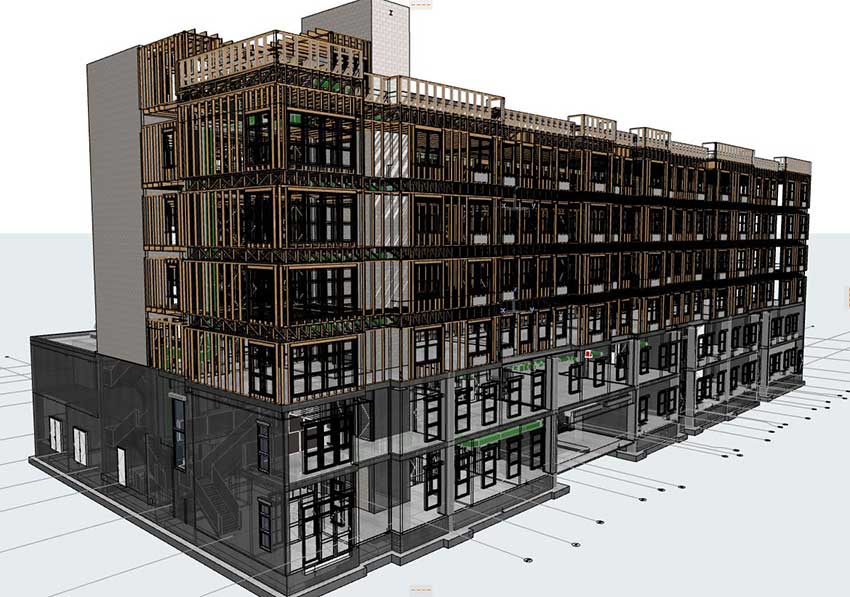
Image courtesy of Kitchen & Associates
Brook Street Lofts is a transit-oriented development in New Jersey that was designed by Kitchen & Associates, who used BIM to work in collaboration with out-of-house consultants, from Boise, Idaho, to Feasterville, Pa.
Unique to this project was the design team. Kitchen & Associates, based in Collingswood, New Jersey, worked with out-of-house consultants, collaborating with the Riverstone Structural Concepts team from Boise, Idaho, and the Holstein White MEP team from Feasterville, Pennsylvania.
The design team can take one project file from conceptual schematic sketches through construction documents. It uses a multitude of features and plug-ins that enable designers to create realistic renderings, video, and VR walk-throughs from one file. Users can communicate internally on the project within the database.
Like Fuse Architects, Kitchen & Associates transferred to a BIM platform when their firm and size of projects started growing. They needed something to produce design and documentation in a way that achieved profitability, coordination, and quality and met timelines.
In-house, K&A had a robust custom template, custom object library, and standards manual, but working with outside teams meant being able to import, export, and integrate. Though K&A has in-house MEP engineering, they had such a high volume of work that they needed to work with outside teams in addition to in-house. Working within the BIM software allowed for real-time collaboration for teams in three different places across the U.S.
The way BIM could update the structural model for designers and clients without document exchange was their biggest attraction to working with the tool. The engagement was a plus, and reviewing conflicts took less time, which kept projects on schedule and reduced costly mistakes and do-overs because everyone was on the same page—literally—from the beginning, addressing problems before permits were issued.
K&A notes that having everyone working in one model and streamlining the process still required—and encouraged—conversation. In other words, BIM helped with efficiency, but it did not automate the process; human engagement kept the project feeling alive and vibrant, but the communication system was easier and better. One element that helped nurture that engagement: the server chat function in some BIM programs, which can help keep communication fluid and remind everyone that they are part of a team. K&A found they could make some rules to help keep the team happy in this collaborative setting, one of which was: If you create something, you can edit it. If not, ask first.
Having each discipline in the same model, with everyone designing and modeling their respective building elements to size in 3D, helps the entire design team work more efficiently and more accurately. It cuts out the “dead time” of creating and sending PDFs and the back-and-forth review that emailing documents involves. Identifying coordination conflicts during the design phase results in fewer coordination issues in the field and a smoother construction process.
These small time-savers add up, K&A notes. They can cut out lots of time and reduce the budget, and the focus can be turned on the creative 3D collaboration—the heart of the project. For K&A, being able to have an architect and structural engineer in one file—and to have them both looking at the exact same view—cuts down coordination efforts that can sometimes spread out over weeks.
The accuracy aspect is also highly important. Architects and engineers working in the same 3D space clarifies design intent. Architects can see ductwork and plumbing, which can situate them in the design better to visualize how all the pieces of their design work together. It can provide another layer of education for all stakeholders, who are able to absorb the way another team works and the elements and parameters they deal with. It offers a well-rounded education through the experience of working in a holistic 3D model. That can help improve all aspects of building and improve the way each team might approach certain problems then and in the future.
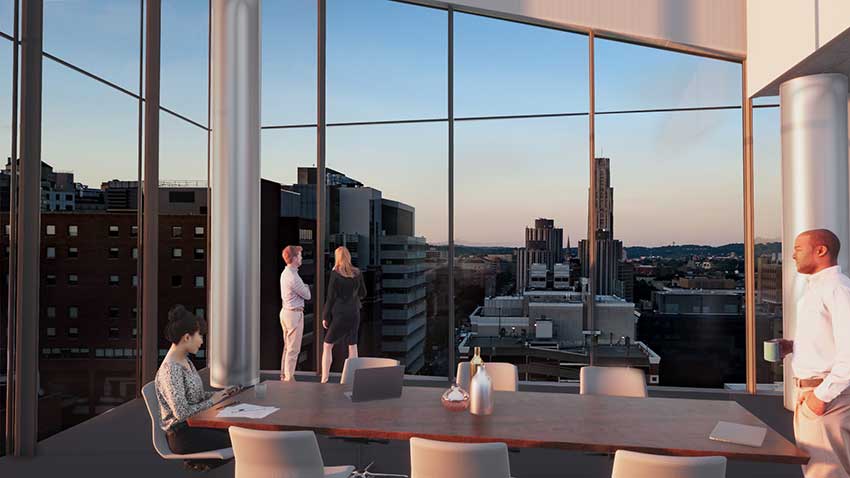
Image courtesy of Strada
The Innovation Research Tower, a 10-story building located in the “innovation district” of Oakland, Pa., that was able to use a variety of BIM tools to experiment with curtain walls and develop a multitude of prototypes that would have otherwise taken too long to create and test.
UNCOVERING OPPORTUNITIES FOR SUSTAINABILITY
Architects are increasingly interested in reducing the environmental impact of the buildings they design—and for good reason. Buildings account for nearly 40% of C02 emissions. C02 emissions are directly responsible for climate change, which we now know will continue to have far-reaching negative impacts if no action is taken. To mitigate climate change, the latest Intergovernmental Panel on Climate Change (IPCC) report states that global warming needs to be limited to 2.7°F (1.5°C). That goal, the report says, requires a “rapid and far-reaching” transition in land, energy, industry, buildings, transport, and cities. The climate change message can often feel dire, but, in fact, it is one of great opportunity: With the right tools and approach, the built environment can go from being a major contributor to climate change to becoming a leader in innovative solutions.
Of the annual emissions from buildings, 28% are due to building operations, while emissions from building materials and construction (referred to as embodied carbon) are responsible for an additional 11%. Unlike operational carbon emissions, which can be reduced over time with building energy upgrades and the use of renewable energy, embodied carbon emissions are locked into place as soon as a building is built. For this reason, predicting emissions and reducing carbon impacts from the beginning of a building project is essential. Architect 2030, a nonpartisan, nonprofit organization working to rapidly transform the built environment from emitter to climate solver, states on its website that getting a handle on embodied carbon now will help the U.S. hit the net-zero emissions goals of the Paris Climate Accord by 2050 and aid in moving the world toward a better climate future.
In conjunction with climate change, new construction is on the rise, which means assessment tools for embodied carbon are more important than ever. Achieving net-zero embodied emissions will require adopting three principles: reuse, reduce, and sequester. Reusing includes renovating existing buildings, using recycled materials, and designing for deconstruction. Reducing includes material optimization and specification of low- to zero-carbon materials, and sequestering means looking for opportunities to use carbon sequestering materials.
Working with MEP/structural engineers in real-time allows designers to uncover opportunities for reducing material use and waste during construction. Early collaboration and design fluidity helps provide opportunities to discover more sustainable construction approaches and materials, as well as pinpoint and incorporate energy-saving building technologies into the process, including core plumbing and increased insulation/air tightness, on-site power generation, and water reduction opportunities.
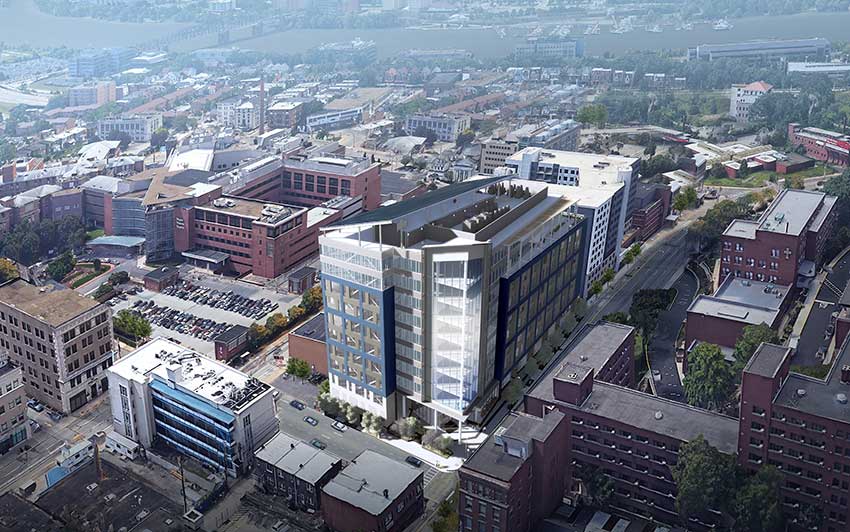
Photo courtesy of Strada
The Innovation Research Tower was able to obtain LEED Gold certification because of development through BIM, despite the fact that the laboratories in the building have high air and energy demands.
Case Study: Strada
The Innovation Research Tower is a 10-story building located in the “innovation district” of Oakland, Pennsylvania. It houses research and development companies that partner with nearby universities, including the University of Pittsburgh and the University of Pittsburgh Medical Center.
The design concept was created by Strada, a cross-disciplinary firm that focuses on collaboration between architects, interior designers, urban designers, landscape architects, and graphic designers. For this project, Strada worked with a local nonprofit, the Oakland Planning and Development Corporation, and developer Walnut Capital to develop a plan for a retail space for businesses that would not otherwise be able to afford rent in the area.
The building required zoning board adjustments for variance approval of height and area. The firm created a model through BIM software and utilized plug-ins that allowed them to virtually drop the model into the site to show what it would look like in the district once it was finished. They also used BIM-compatible, real-time visualization to make presentations to the developers and potential tenants. They were able to create multiple iterations of the building during the design phase to show the possibilities, using accurate construction components, which would lay the groundwork for the next phase of construction documents.
One of the most important aspects of using BIM for the Innovation Research Tower was the ability to design built-in building efficiencies from the beginning. Through a variety of tools, the designers were able to experiment with curtain walls and develop a multitude of prototypes that would have otherwise taken too long to create and test. The tower is LEED Gold certified, despite the fact that the laboratories in the building have high air and energy demands. However, the general core of the building—created through BIM modeling—meets LEED Gold standards, with solar panels installed on the roof to power the base core lobby lighting and general services of the building.
Modern design software has evolved way past the point of simple 2D and 3D renderings. The BIM work process, coupled with innovative developments in design software, enables real-time collaboration among all project stakeholders. Designers and MEP and structural engineers can visualize all aspects of the design process in complete 3D renderings and, in doing so, can incorporate progressive and innovative sustainable design options seamlessly into the plans. By taking advantage of the technology available, architects and designers can reduce design time, improve communication, and identify and resolve potential design conflicts, while fostering a supportive remote workforce.

Photo courtesy of Chris Ambridge of CG+S
The Duke Ellington School of the Arts in Washington, D.C.
Bim On The Rise: The Magic Of Collaborative Modeling
Building information modeling (BIM) is an intelligent software modeling process supported by a variety of tools and technologies. It is utilized by architects, engineers, and contractors to collaborate on building design, construction, and operation, using files that can be extracted, shared, and networked to support 3D collaboration and real-time decision making.
BIM has provided collaborative solutions within architecture firms, opening up possibilities within the architecture, engineering, and construction (AEC) industry. When used with intelligent workflow software and a 3D model, BIM provides all project planners and implementing companies involved in a project with information and tools for efficient planning, design, construction, and administration of buildings and infrastructure. Architecture firms have been moving rapidly toward this trend, and it is quickly becoming an industry standard when specifying and designing projects.
BIM is the process and practice of virtual design, construction, and management throughout a building’s life cycle. The modeling platform is data-rich and allows designers and building professionals to generate 3D models (and drawings). BIM can include information about all aspects of a building, from designs, decisions, product specifications, and building space use to operations management. The modeled information also can be used for building analyses—for example to check building codes, calculate costs, or simulate energy use.
Key BIM data include the geometry of the project, the physical properties of the materials (e.g., construction materials, visuals properties), the types of buildings or spaces, and cost and time schedules. The object-oriented model is tied to a central database accessible to all project participants. The data can be used to generate high-quality 3D renderings to present a building concept for a bid or to help architects visualize and analyze specific design elements, such as energy use.
Software allows users to work with data-enhanced parametric objects—AKA “smart objects.” They can create virtual buildings with structural elements such as walls, slabs, roofs, doors, windows, and furniture. Some software programs come with customizable objects complete with texture, background, and lighting files. Two-dimensional objects can be exported at any time and incorporated into the model. Plans, elevations, and sections are generated from the virtual building model and are updated as the user “rebuilds.” Detail drawings come from an enlarged portion of the model with 2D detail added in.
BIM software can link via application programming interface (API) for third-party add-on developers. The ability to integrate a visual programming language and design applications allows applications to “talk” with each other and provide access to growing object and product libraries, and connection to new, innovative, and complementary software is key to the successful universe of BIM. The software can import and export DWG, DXF, IFC, and BCF files, among others. Through Open BIM, 3D BIM data exchange can happen between different design disciplines on open-source platforms.
All these tools help to build better buildings faster and more efficiently, while realizing the architectural vision. But perhaps one of the most important aspects of the software and unique real-time 3D modeling is how it can transform workflows and, in the end, transform the AEC culture, opening new possibilities for collaboration that lead to inspired projects. By taking advantage of the technology available, architects and designers can reduce design time, improve communication, and identify and resolve potential design conflicts, while fostering a supportive remote workforce.

Photo courtesy of iStock
BIM is the process and practice of virtual design, construction, and management throughout a building’s life cycle and can include information about all aspects of a building—from designs, decisions, product specifications, and building space use to operations management.
BIM enables project-wide decision making, and the virtual model easily can be handed off from the design team to other building professionals, such as contractors or the owners. Project information remains intact and thus helps each professional understand the building specifications throughout the building’s life cycle. When changes are made, those changes are sent to the server, allowing remote access to the same project over the internet. Use of BIM over the cloud integrates through browser-based management, LDAP connection, and HTTP/HTTPS-based communication. In addition, new scalability options are available, allowing for multi-server layouts to be created with option-caching servers.
The AEC industry has more demands on it than ever—with needs ranging from pathogen-fighting designs to more flexible work, play, and education spaces. With the challenges brought on by a pandemic, in which the industry has found itself in the world of remote collaboration, there have come exciting prospects for innovation and a reimagining of how buildings are made.

Photo courtesy of iStock
One of the newest BIM tools being developed is a virtual reality (VR) component to the 3D model, which enables designers and clients to walk through these virtual spaces and have an immersive experience of the building design.
Saving Time And Improving Communication
Real-time collaboration and fast, easy file sharing solves a multitude of problems for industry stakeholders. Early collaboration in the BIM process leads to fewer pre-permit design conflicts. The ability to design, specify, and resolve project details in single meetings reduces prolonged back-and-forth situations, reducing the chances of miscommunication. It helps move projects forward on an efficient timeline that stays within budget. In addition, fast file sharing can be accomplished even on slower internet speeds, which supports global collaboration and remote workspaces, and expands the possibilities for a variety of collaborator locations. This type of real-time, inclusive collaboration offers financial gains to firms, including team recruitment and retention.
One of the newest BIM tools being developed is a virtual reality (VR) component to the 3D model. Beyond creating beautiful, detailed renderings, the technology now exists to enable designers and clients to walk through these virtual spaces. Some BIM software can export a 3D file onto an iOS or Android smartphone and allow a designer or client to use a VR platform, such as Google Cardboard, to have an immersive experience of the building design.
Exploring residential and commercial buildings through VR with a smartphone and a viewer offers the design community an avenue for engaging clients and communicating design intent in a high-tech, low-cost way. The BIM files can be exported in under 15 minutes and will provide images at the resolution level supported by the smartphone technology used. Some BIM software can provide the files in a number of file formats, enabling designers to save their projects out to third-party applications.
Case Study: Fuse Architecture
Fuse Architecture, founded in 2000, is a full-service design and construction firm based in Santa Cruz, California. It has a staff of about 24 and is composed of three divisions: construction, interior design, and architecture. Like so many other architecture firms, Fuse began working in computer-aided design (CAD) software. Designers drew their initial projects by hand in 2D and then created computerized versions in 3D. As technology for architecture developed, the company began to feel the weight of technology overload. They were using many different programs that could not integrate with one another. They had multiple subscriptions with multiple logins, which took time to navigate, cluttered the server, and created a disconnected feeling within projects.

Photo courtesy of FUSE
Fuse is a full-service design and construction firm based in Santa Cruz, Calif., that transformed its workflow using BIM software, allowing for more collaboration and visualization on projects such as this residence in Pajaro Dunes, Calif.
A few years ago, a Fuse employee started experimenting with a BIM platform to save time. This experimentation piqued the interest of the company owners, and it sent the firm down a new path that would change their entire approach. For the first time ever, Fuse started working in 3D from the start of a project, even in the concept and study phases. Teams from all departments were able to contribute ideas to this shared model, shaping it and expanding it collaboratively without the limiting issues of having to switch to different software for visualization, presentation, and documentation. In addition, these steps in the process were nonlinear and fluid: A concept in one phase was not necessarily set in stone as it might have been in the 2D-to-CAD process. In other words, designers could go back to early ideas and make changes without disrupting the flow or “starting over.” This kind of workflow encouraged the consideration of more ideas (and more creative ideas) from all stakeholders. At the same time, it streamlined the process, which allowed everything to move faster and more efficiently.
The fact that visualization, presentation, and documentation can exist on one platform, and even within one model, allows for better communication between departments. This was also the case when the firm was working with contractors outside the office. According to one Fuse project manager, many of the firm’s residential contractors who were not in-house were used to seeing designs in 2D. When they were able to see the BIM designs, they could more easily provide immediate feedback. In some instances, that meant pointing out a potential problem or identifying efficiencies, and in other instances it meant they could offer creative ideas that inspired the designers toward better designs. This engagement in the creative collaborative process from the contractors was new and refreshing, Fuse reported. “They feel like—which is very rare—that they are part of the design phase,” said Fuse partner and co-founder Dan Townsend.
Clients comprised another important stakeholder with whom Fuse was able to engage through BIM software. Using simplified VR compatibility and turning their 3D models into rich, detailed experiences, Fuse could immerse clients early and often into the project. The client was able to respond to the project—both in emotional and rational ways—and the firm could incorporate that feedback into its process. Having that dynamic with the client throughout the project, Fuse said, made the process more exciting and fulfilling.
This holistic approach through BIM creates a holistic environment in the firm. A full-service firm like Fuse requires a creative dynamic where the departments can work in an integrated fashion. Rather than forcing a workplace to conform to its parameters, BIM can meet the needs of stakeholders where they flourish most. For instance, many designers are artists with drawing backgrounds who thrive with a pencil in hand. Rather than treating pencil and paper as tools of antiquity and trying to eliminate them, BIM provides opportunities for designers to sketch and draw ideas even as the 3D design is in full effect—and seamlessly integrating the 2D renditions into the model.
In one project, Fuse was able to do a feasibility study within the BIM program to help in a request for a zoning law variance. Before a single wall was designed, the firm conducted a sun study using a model of a proposed building and how it would interact with the sun throughout the year. They were able to show that the building would not shadow neighboring buildings or restrict access to the sun. They were able to produce the study for the neighbors—yet another stakeholder benefiting from early 3D modeling—who got to have input and feel part of the project. The support from neighbors helped in getting permission from zoning commissioners to approve the project, which might not have happened if everyone did not have access to the context and tools supplied by BIM.
Within 18 months of their switch to a BIM platform, architects at Fuse reported seeing major productivity gains and more creativity and cohesion. Teams are more eager and invested in their projects than ever before because they have tools that are efficient and flexible and which open what seem like endless possibilities for design and collaboration.
Case Study: Brook Street Lofts—A One-Team, One-Model Approach
Brook Street Lofts is a new construction, 245,000-square-foot, transit-oriented development in New Jersey. The six-story, mid-rise building consists of four floors of residential housing above two floors of noncombustible garage parking for building occupants as well as walk-up residential units on the first two floors along Brook Street. Brook Street Lofts contains a total of 146 residential units of mixed-income-family rental housing.

Image courtesy of Kitchen & Associates
Brook Street Lofts is a transit-oriented development in New Jersey that was designed by Kitchen & Associates, who used BIM to work in collaboration with out-of-house consultants, from Boise, Idaho, to Feasterville, Pa.
Unique to this project was the design team. Kitchen & Associates, based in Collingswood, New Jersey, worked with out-of-house consultants, collaborating with the Riverstone Structural Concepts team from Boise, Idaho, and the Holstein White MEP team from Feasterville, Pennsylvania.
The design team can take one project file from conceptual schematic sketches through construction documents. It uses a multitude of features and plug-ins that enable designers to create realistic renderings, video, and VR walk-throughs from one file. Users can communicate internally on the project within the database.
Like Fuse Architects, Kitchen & Associates transferred to a BIM platform when their firm and size of projects started growing. They needed something to produce design and documentation in a way that achieved profitability, coordination, and quality and met timelines.
In-house, K&A had a robust custom template, custom object library, and standards manual, but working with outside teams meant being able to import, export, and integrate. Though K&A has in-house MEP engineering, they had such a high volume of work that they needed to work with outside teams in addition to in-house. Working within the BIM software allowed for real-time collaboration for teams in three different places across the U.S.
The way BIM could update the structural model for designers and clients without document exchange was their biggest attraction to working with the tool. The engagement was a plus, and reviewing conflicts took less time, which kept projects on schedule and reduced costly mistakes and do-overs because everyone was on the same page—literally—from the beginning, addressing problems before permits were issued.
K&A notes that having everyone working in one model and streamlining the process still required—and encouraged—conversation. In other words, BIM helped with efficiency, but it did not automate the process; human engagement kept the project feeling alive and vibrant, but the communication system was easier and better. One element that helped nurture that engagement: the server chat function in some BIM programs, which can help keep communication fluid and remind everyone that they are part of a team. K&A found they could make some rules to help keep the team happy in this collaborative setting, one of which was: If you create something, you can edit it. If not, ask first.
Having each discipline in the same model, with everyone designing and modeling their respective building elements to size in 3D, helps the entire design team work more efficiently and more accurately. It cuts out the “dead time” of creating and sending PDFs and the back-and-forth review that emailing documents involves. Identifying coordination conflicts during the design phase results in fewer coordination issues in the field and a smoother construction process.
These small time-savers add up, K&A notes. They can cut out lots of time and reduce the budget, and the focus can be turned on the creative 3D collaboration—the heart of the project. For K&A, being able to have an architect and structural engineer in one file—and to have them both looking at the exact same view—cuts down coordination efforts that can sometimes spread out over weeks.
The accuracy aspect is also highly important. Architects and engineers working in the same 3D space clarifies design intent. Architects can see ductwork and plumbing, which can situate them in the design better to visualize how all the pieces of their design work together. It can provide another layer of education for all stakeholders, who are able to absorb the way another team works and the elements and parameters they deal with. It offers a well-rounded education through the experience of working in a holistic 3D model. That can help improve all aspects of building and improve the way each team might approach certain problems then and in the future.

Image courtesy of Strada
The Innovation Research Tower, a 10-story building located in the “innovation district” of Oakland, Pa., that was able to use a variety of BIM tools to experiment with curtain walls and develop a multitude of prototypes that would have otherwise taken too long to create and test.
UNCOVERING OPPORTUNITIES FOR SUSTAINABILITY
Architects are increasingly interested in reducing the environmental impact of the buildings they design—and for good reason. Buildings account for nearly 40% of C02 emissions. C02 emissions are directly responsible for climate change, which we now know will continue to have far-reaching negative impacts if no action is taken. To mitigate climate change, the latest Intergovernmental Panel on Climate Change (IPCC) report states that global warming needs to be limited to 2.7°F (1.5°C). That goal, the report says, requires a “rapid and far-reaching” transition in land, energy, industry, buildings, transport, and cities. The climate change message can often feel dire, but, in fact, it is one of great opportunity: With the right tools and approach, the built environment can go from being a major contributor to climate change to becoming a leader in innovative solutions.
Of the annual emissions from buildings, 28% are due to building operations, while emissions from building materials and construction (referred to as embodied carbon) are responsible for an additional 11%. Unlike operational carbon emissions, which can be reduced over time with building energy upgrades and the use of renewable energy, embodied carbon emissions are locked into place as soon as a building is built. For this reason, predicting emissions and reducing carbon impacts from the beginning of a building project is essential. Architect 2030, a nonpartisan, nonprofit organization working to rapidly transform the built environment from emitter to climate solver, states on its website that getting a handle on embodied carbon now will help the U.S. hit the net-zero emissions goals of the Paris Climate Accord by 2050 and aid in moving the world toward a better climate future.
In conjunction with climate change, new construction is on the rise, which means assessment tools for embodied carbon are more important than ever. Achieving net-zero embodied emissions will require adopting three principles: reuse, reduce, and sequester. Reusing includes renovating existing buildings, using recycled materials, and designing for deconstruction. Reducing includes material optimization and specification of low- to zero-carbon materials, and sequestering means looking for opportunities to use carbon sequestering materials.
Working with MEP/structural engineers in real-time allows designers to uncover opportunities for reducing material use and waste during construction. Early collaboration and design fluidity helps provide opportunities to discover more sustainable construction approaches and materials, as well as pinpoint and incorporate energy-saving building technologies into the process, including core plumbing and increased insulation/air tightness, on-site power generation, and water reduction opportunities.

Photo courtesy of Strada
The Innovation Research Tower was able to obtain LEED Gold certification because of development through BIM, despite the fact that the laboratories in the building have high air and energy demands.
Case Study: Strada
The Innovation Research Tower is a 10-story building located in the “innovation district” of Oakland, Pennsylvania. It houses research and development companies that partner with nearby universities, including the University of Pittsburgh and the University of Pittsburgh Medical Center.
The design concept was created by Strada, a cross-disciplinary firm that focuses on collaboration between architects, interior designers, urban designers, landscape architects, and graphic designers. For this project, Strada worked with a local nonprofit, the Oakland Planning and Development Corporation, and developer Walnut Capital to develop a plan for a retail space for businesses that would not otherwise be able to afford rent in the area.
The building required zoning board adjustments for variance approval of height and area. The firm created a model through BIM software and utilized plug-ins that allowed them to virtually drop the model into the site to show what it would look like in the district once it was finished. They also used BIM-compatible, real-time visualization to make presentations to the developers and potential tenants. They were able to create multiple iterations of the building during the design phase to show the possibilities, using accurate construction components, which would lay the groundwork for the next phase of construction documents.
One of the most important aspects of using BIM for the Innovation Research Tower was the ability to design built-in building efficiencies from the beginning. Through a variety of tools, the designers were able to experiment with curtain walls and develop a multitude of prototypes that would have otherwise taken too long to create and test. The tower is LEED Gold certified, despite the fact that the laboratories in the building have high air and energy demands. However, the general core of the building—created through BIM modeling—meets LEED Gold standards, with solar panels installed on the roof to power the base core lobby lighting and general services of the building.
Case Study: Mjøstårnet
The tallest timber building in the world sits on the bank of Norway’s Lake Mjøsa in the town of Brumunddal, just 140 km from Oslo. It’s a majestic and artistic design, created by Volle Arkitekte, an architecture firm based in Trondheim. The 18-floor, nearly 295-foot-high, mixed-use building is composed of a hotel, office spaces, and apartments, plus public viewing terrace, public swimming pool, and restaurant. It required an unparalleled level of skill to build an all-wood building on this scale with such efficiency and achieve the goal of becoming a model for sustainability—and it could not have been done without BIM.
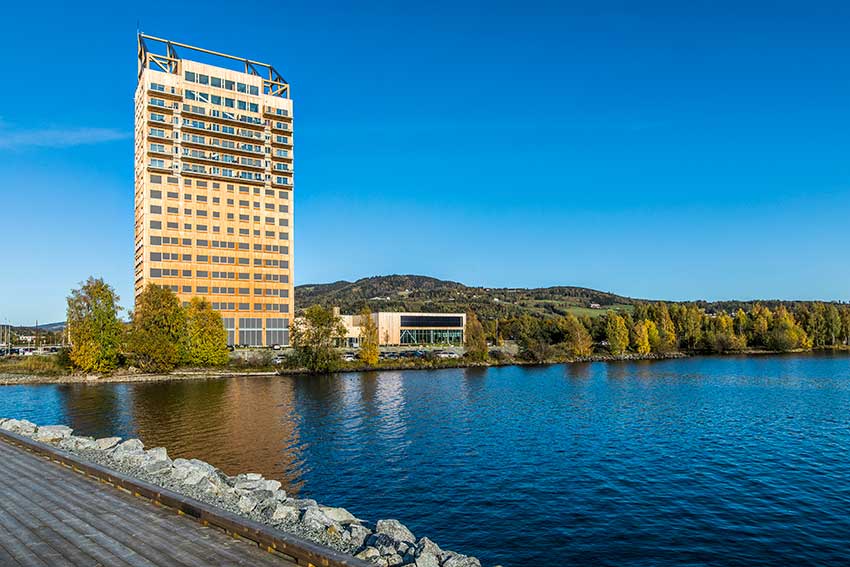
Photo courtesy of Volle Arkitekte
The tallest timber building in the world, situated on the bank of Norway’s Lake Mjøsa, required unparalleled skill and BIM software to build on this scale with such efficiency and achieve the goal of becoming a model for sustainability.
Volle Arkitekte, a 24-employee firm, challenged themselves with this project to prove it could be done and to provide leadership in the “green shift” many architects know needs to take place within the industry. The high-profile project constitutes the first time in modern history of a project on this scale in which the materials and expertise were sourced locally and sustainably.
Brumunddal is famous for its forestry and wood processing. Using wood from and processing in the area meant cutting down and transporting wood, supporting the local economy, while also providing a demonstration for how projects could source locally. Sustainable management is imperative to this kind of model project. The firm wanted to support sustainable practices, and wanted to do it in Norway, where foresters are required to facilitate new growth when forests are harvested.
Spruce was grown and harvested, cut into boards at the local mill, and made into glulam products nearby. Elements for the building were created at a manufacturer located just across the street from the site.
BIM played an important role in maintaining the sustainable integrity of the project. With so much care taken at the beginning to facilitate sustainable practices, the design and construction process needed be time efficient, reduce material waste, and result in a building that would stand the test of time. Keeping track of the dimension and placement during the design phase was essential to the workflow. BIM models were able to show how to place the diagonal trusses in conjunction with windows in a way that they did not steal daylight.
Once Volle Arkitekte completed the design, the local construction company they worked with was able to import the IFC model into their software and used that to prepare the beams, trusses, and columns into production units. These were coded and bundled together and shipped to the site without any trial assembly. Given the complexity of joinery and uniqueness of each piece and the precision required to put them together, this might have seemed like a risky move. But the BIM model integrated the design with construction documents and precise manufacturing so well that only one of several hundred glulam elements had to be re-machined. Having all the details in order from beginning to end, in a single BIM model that could be molded and scrutinized from the beginning, allowed for savings in transportation and fabrication costs and resulted in very little materials waste because there were very few errors.
Another sustainability aspect was the use of acid-proof steel for each floor’s visible flashing. The material prevented rust drippings that could have affected the cladding and deteriorated it over time. The designers and engineers also specified vertical board panels with extra vertical tracks that would help control any dripping from surfaces due to weather. The BIM model was able to show exactly how the building would handle weather and aging impacts, and the designers were able to create solutions from the beginning that would impact the longevity of the building—providing it another level of sustainability.
There were also important safety factors built into the 3D model: The overall terrain level was raised to withstand a 200-year flood, making sure that residents and users of the tower had a secure escape route in case of a flood.
Assembly of the Mjøstårnet was done by crane, with four to five floors lifted at a time. It took just one year to erect the complex building simply because so much efficient work was done in the BIM design process, which created efficiencies down the line and resulted in a timeline that benefited the project, cutting costs and energy needs.
It’s important to note that the design itself reflects sustainable values. From the public viewing decks on the 18th and 19th floors, a person can look out and see the forests of spruce trees from which the building is made and the mills where it was processed. The wooden beams of the building are not just functional, they are part of the design, as are the glulam trusses that stretch from ground floor to top and are visible through the windows. All these elements are aesthetic and meant to create a “readable facade” with a purpose. They serve as a representation of sustainability and a connection to nature—and a statement that is meant to encourage other designers to build in sustainable ways.
Improving Comfort And Aesthetics Through Creative Collaboration
Indoor environmental quality (IEQ) refers to the quality of a building's interior environment in relation to the health and well-being of those who occupy it. Components of IEQ include indoor air quality (IAQ), lighting and daylighting, aesthetics, and acoustics, all of which are important elements for architects to consider. When IEQ is poor, occupants suffer long-term and short-term physical and mental effects. According to the U.S. Environmental Protection Agency (EPA), Americans spend, on average, about 90% of their time indoors. For this reason, IEQ design becomes even more crucial.
Furthermore, the people most susceptible to adverse effects of poorly designed spaces—the very young, older adults, and people with medical conditions—tend to spend even more time indoors.
Poor IEQ can affect communication, concentration, and sleep, leading to stress responses such as high blood pressure. New research has shown that aesthetics, daylighting, and other IEQ components are particularly important for healthcare, education, and office designs—in other words, where people heal, learn, and work.
IEQ has become a gold standard for design. As people head back to the workplace, and schools and medical centers adjust to new standards for the health, safety, and well-being of their occupants, architects must stay on the cutting edge for specifying materials to achieve those designs.
Real-time collaborative design meetings allow for a more creative workflow and the opportunity to include innovative design elements that support IEQ. With 3D visualization, designers, architects, and MEP/structural engineers can identify opportunities for natural lighting and ventilation, biophilic design, and other elements that meet IEQ goals. Using visualization, they can see how these design choices will impact the experience of occupants before construction begins.
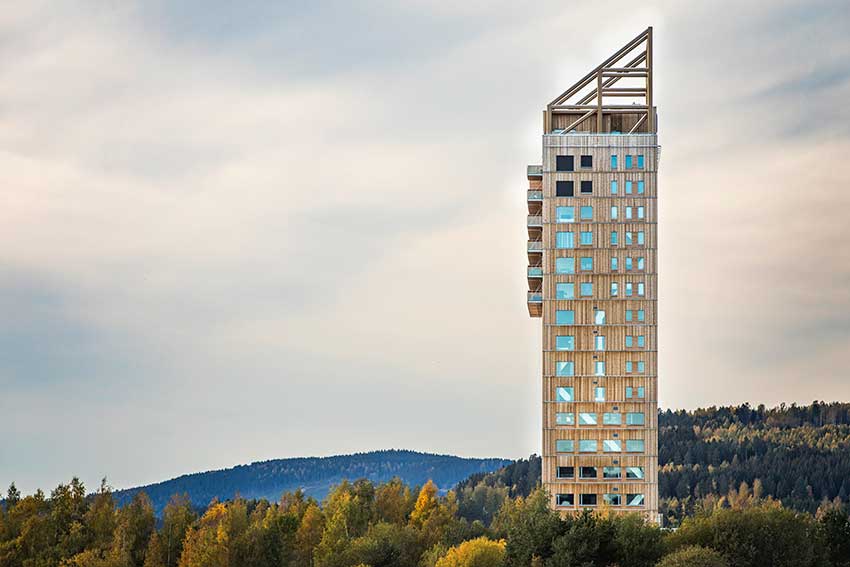
Photo courtesy of Volle Arkitekte
The town of Brumunddal, Norway, where Mjøstårnet was built, is famous for forestry and wood products, which allowed for a BIM model involving sustainable practices that support the local economy and provide green building leadership.
Conclusion
Recent advances in technology have opened doors for innovative collaboration in the world of architecture, engineering and construction. BIM software is one way all stakeholders can take part in real time to discover better designs that attain historic preservation, sustainability and aesthetic goals in seamless, cost-effective ways. In this course we learned that not only does BIM provide great opportunities for demonstrating best-practice designs, it also transforms architectural, engineering and construction firms and companies in profound ways, as those in the AEC field discover that they are able to envision and execute great projects within a dynamic and creative workplace.
Erika Fredrickson is an independent writer and editor focusing on technology, the environment, and history. She is a frequent contributor for continuing education courses and publications through Confluence Communications www.confluencec.com









